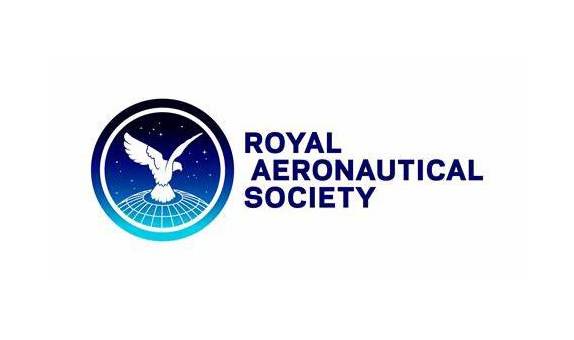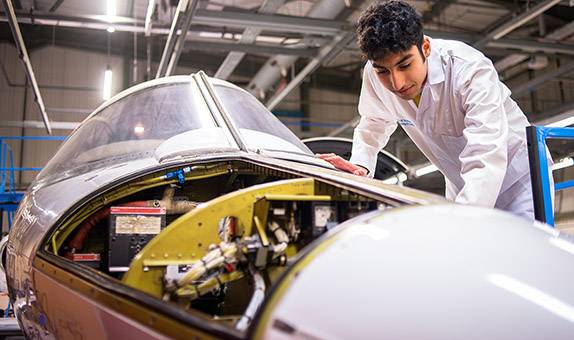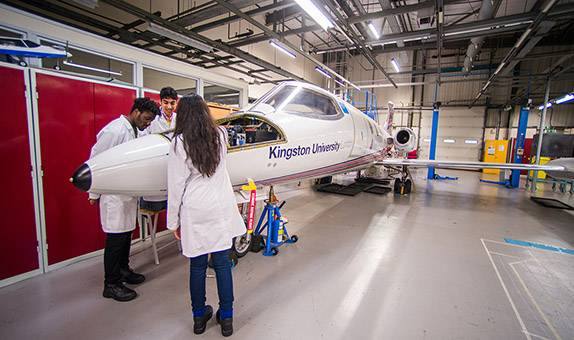Aircraft Engineering FdEng
Why choose this course?
This course is a progression programme and is specifically designed to help meet the growing need for skilled aircraft maintenance engineers. As part of the programme, you will gain the knowledge requirements for the EASA Part 66 B1.1 licence. You will also receive practical hand skills training in the purpose-built basic workshop facilities.
This course is designed to produce licensed aircraft maintenance engineers with the capacity to progress onto the BEng (Hons) top-up course, obtain an honours degree and become aircraft maintenance managers of the future.
The course introduces students to aircraft engineering hand and maintenance skills and provides them with opportunities to put the skills into practice. It also introduces the study skills necessary for successful completion of the course in the first year and develops and expands these skills in the second year to prepare the students for progression to the top-up.
This course is taught at Exeter College and awarded by Kingston University.
| Where taught | Attendance | UCAS code | Year of entry |
|---|---|---|---|
| Exeter college | 2 years full time | 2H60 | 2024 2025 |
| Main Location | Exeter college |
Reasons to choose Kingston University
- This course provides students with the professional knowledge and skills that will enable them to manage their own and encourage them to be proactive in their personal and professional development.
- The course introduces students to aircraft engineering hand and maintenance skills and provides them with opportunities to put the skills into practice.
- The course gives you the skills and knowledge to progress onto the Aircraft Engineering Top-up course.
What you will study
The course is operated in accordance with the KU Undergraduate Regulations and modules are compulsory; there are no optional modules available. To be awarded an FdEng Aircraft Engineering, students must pass all 240 credits. A student is eligible for the award of a Certificate of Higher Education (CertHE) provided they successfully complete at least 120 credits of the programme at Level 4 or above.
You can contact the Exeter College liaison officer garyherrington@exe-coll.ac.uk for further details about Exeter College and the course.
Year 1
Year 2
Core modules
Mathematics and Physics for Practitioners
30 credits
This module covers all of the topics in the EASA part-66 Mathematics and Physics syllabuses, and provides the knowledge and understanding sufficient for the students to take the associated EASA category B licence examinations that must be passed in order to become an aircraft maintenance engineer.
It also extends the mathematics knowledge to a level sufficient to underpin key engineering principles and prepare students for the mathematics in the level 6 modules of the programme and further study. Additional topics beyond EASA Mathematics and Physics syllabuses include but not limited to: probability, statistical methods and applications, matrix algebra, vectors, applications of calculus and elementary differential equations.
To become a design engineer a student would need to complete some additional mathematics and science study at level 5.
Electrical Engineering Fundamentals
30 credits
This module comprises both theory and practical. The theory is delivered in a series of lectures and the practical involves the student completing a series of laboratory sessions designed to reinforce the knowledge gained in the lectures.
The module starts by looking at electrical charge and how electricity is created, before moving on to look at passive components such as resistors, capacitors and inductors and how they behave in simple direct current (d.c.) circuits. The study of inductors leads nicely into the topic of magnetism and then onto d.c. generators and motors which starts by exploring the fundamental principles of machines before moving on to look at various basic types.
The second part of the module focuses on alternating current (a.c.). Firstly passive components are revisited, this time in basic a.c. circuits. The relationship between: resistance, reactance and impedance; voltage, current and impedance; and reactive, true and apparent power are examined in the class and tutorial sessions whilst simple circuits containing combinations of resistors, capacitors and inductors are explored in the laboratory. Induction is then revisited for transformers before the final section which covers the theoretical aspects of a.c. generators and motors before looking at typical aircraft a.c. machines.
Aerodynamics and Theory of Flight
15 credits
This module will initially establish the need for a standard atmosphere (ISA) and describe the properties of the atmosphere as applicable to aerodynamics. The module will investigate the airflow around a body and the generation of lift and drag. Relevant terminology and formulae will be introduced and calculations performed. The module will go on to discuss lift augmentation and stability; specifying design features affecting these. High speed flight is then discussed, including design features associated with critical Mach number. The module will conclude with a look at the characteristics of aerofoils at all speeds of flight.
Aircraft Electronic and Digital Systems
15 credits
This module is a combination of electronics, digital techniques and aircraft digital systems. The electronics section starts by looking at the building block of semiconductor components: the P-N junction, this is followed by a look at the characteristics, uses, and basic testing of diodes and transistors.
Basic logic gates are then introduced, and combinational and sequential logic circuits examined. Op amps are studied and basic A to D and D to A conversion techniques investigated. The section concludes with look at the transducers and synchronous data transmission systems found on aircraft.
In digital techniques, computer terminology and the basic layout and operation of computers is studied before looking at the use of computer technology in aircraft. Aircraft specific databus systems and displays techniques are also studied prior to moving onto the final section of the module: digital systems.
The last section involves investigating the layout, operation and built-in-test equipment (BITE) of a selection of electronic and digital aircraft systems including: Electronic Flight Instrument systems (EFIS), Electronic Centralised Aircraft Monitor system (ECAM), Engine Indicating and Crew Alerting System (EICAS), Fly-by-Wire (FBW), Inertial Reference Systems (IRS), and the Flight Management System (FMS)
Aircraft Practical Hand Skills and Sustainability
15 credits
The aircraft element of the module will give students an opportunity to develop basic hand and aircraft maintenance skills. The module is not intended to turn the student into skilled experts; rather it is designed to provide a thorough introduction and solid grounding for further training, practice and development.
The hand-skills experience will include: an introduction to the tools and materials that will be used, reading basic engineering drawings, marking out, cutting, filing, drilling, and thread cutting etc. When completing the initial tasks, students will be closely supported and guided; however the level of guidance will decrease as the module progresses and the tolerances to which the student work will be expected to increase. The maintenance skills will include: using maintenance manuals, following procedures, completing documentation and fundamental maintenance activities such as: identifying parts, wire-locking, panel removal and refitment and torque loading and assembly and disassembly techniques.
Assessment of this element of the module will be through practical exercises and students will be expected to display maturity, integrity, good work practices and have a responsible attitude towards safety at all time throughout the module.
The module will also explore the environmental, economic, and social problems that society faces and encourage students to find their own sustainable innovative solutions. Focusing on the 21st-century environmental and climate change challenges, the students will learn, explore, debate, and work in teams and will be challenged to:
- unleash the interconnectedness among topics such as Sustainable Development Goals (SDGs), Net Zero Carbon, and Circular Economy
- identify approaches to problem-solving in real-world scenarios
Navigating for Aircraft Engineers
15 credits
This module introduces and provides an opportunity for students to develop the academic skills needed to successfully complete a Higher Education (HE) programme and the basic communication skills needed to become an aircraft maintenance engineer.
The academic element of the module will cover basic research techniques, report writing, referencing, use of IT, maintaining digital records, the fundamentals of working in teams, maintaining a study journal, understanding and using feedback, reflection and personal development through a series of scheduled learning sessions that will comprise a mixture of presentation, lecture, discussion, workshop and tutorial.
Students will maintain a study journal a portfolio of evidence that will be used for both formative and summative assessment purposes. The majority of the material needed for these two documents will be derived from work completed for the other modules in the year.
Core modules
Propulsion Systems
30 credits
The basic principles of operation, construction and performance of gas turbine engines are discussed and the respective terminology introduced. This various component parts (stages) of the engine are examined in detail and the layout and operation of engine systems are studied: fuel, lubrication, air distribution, anti-icing, starting, ignition, power augmentation and fire systems. The material covered should enable the student to inspect the various engine components and systems and make independent decisions regarding serviceability. The module looks at engine monitoring, ground operation and storage of engines. The final part of this topic examines the construction and operation of engine measuring and indication systems.
The module follows with a look at the aerodynamics principles of propellers and their construction, before looking at propeller assemblies, including a detailed study of: propeller pitch control, over-speed mechanisms and protection devices. Finally the module provides an overview of the need for synchronising synchrophasing and an explanation of how this is achieved.
The depth of study is sufficient to enable system serviceability to be confirmed and basic faults to be investigated so that the action necessary to restore the system to a serviceable condition can be taken.
Aircraft Structures and Their Mechanical Systems
15 credits
Aircraft Materials, Hardware and Maintenance
30 credits
This module comprises two parts; the first looks at aircraft materials and hardware and the second covers the theoretical aspects of aircraft maintenance practices. The practical work associated with this module takes place in other modules in the programme.
Part one of this module starts by exploring the characteristics, properties, applications and typical heat treatments of aircraft ferrous and non-ferrous metals before looking at the properties, characteristics and how to repair typical aircraft composite and non-metallic materials. The content of this element extends beyond the EASA syllabus and there will be a greater emphasis on the mechanical and physical characteristics of material, their time dependent behaviour, behaviour under various loading conditions and features related to the service environment. The module also looks at the selection and application of different types of materials in engineering applications. Where appropriate, state-of-the-art problems will be discussed to illustrate the structure-property relationship in materials. The final topic of this part covers aircraft hardware, here the properties, characteristics, uses and identification of fasteners, pipes, bearings, transmission systems, flying controls, and aircraft electrical cables and connectors are examined.
Part two provides students with the knowledge required to select and use the tools, materials, drawings and equipment necessary to perform aircraft maintenance tasks. It also provides them with the knowledge needed to enable them to work effectively and safely in an aircraft maintenance environment. Topics covered include: tools and equipment and their use, aircraft drawings and manuals, inspection and tolerance checking, electrical measurements, disassembly and reassembly, aircraft weighing and weight and balance calculations, aircraft handling; corrosion prevention removal, assessment and re-protection, non-destructive testing, aircraft storage and preservation and finally aircraft maintenance procedures.
Aircraft Electrical & Avionics systems
15 credits
This module first discusses the operation of the electrical systems and avionics systems including but not limited to: electrical power generation and management, lighting. In each case, the depth of study will be sufficient to enable the student to describe the layout of each system, explain its operation and interaction with other aircraft systems and, given a period of time to gain some practical experience, determine the serviceability of the system and investigate and identify basic faults in it.
Practical maintenance experience, fault-finding techniques and an understanding of maintenance procedures and the appropriate action to be taken in the event of finding defects will be gained from other modules in the programme The module also examines aircraft instrument systems including: pitot-static for measuring airspeed and altitude, remote and direct reading compasses, gyroscopic flight instruments; and a number of avionic systems including: on-board maintenance, integrated modular avionics, cabin and information.
HE Study Skills and Explore
15 credits
Students will demonstrate a developing awareness of the skills required to operate as a professional in their subject area. These skills will include the development of teamworking, interpersonal and interdisciplinary skills, critical self-reflection, communication and presentation, time management, and the ability to organise, strategise and prioritise.
Students will develop their personal development plan (via their digital skills portfolio) and begin to explore and evidence how these acquired skills are applied across the portfolio of modules at Level 5.
A key element of this module will be the participation in an inter-disciplinary design thinking project. Students will contextualise their subject-specific knowledge, skills and behaviours as an interdisciplinary team member charged with developing a solution to a designated sustainability challenge.
Human Factors & Aviation Legislation
15 credits
Future Skills
Knowledge to give you the edge
Embedded within every course curriculum and throughout the whole Kingston experience, Future Skills will play a role in shaping you to become a future-proof graduate, providing you with the skills most valued by employers such as problem-solving, digital competency, and adaptability.
As you progress through your degree, you'll learn to navigate, explore and apply these graduate skills, learning to demonstrate and articulate to employers how future skills give you the edge.
At Kingston University, we're not just keeping up with change, we're creating it.

Entry requirements
Teaching and assessment
Scheduled learning and teaching on this course includes timetabled activities including lectures, seminars and small group tutorials.
It may also include placements, project work, workshops, workshops in computer labs, and laboratory workshops.
Who teaches this course?
The Aircraft Engineering FdEng course is awarded by Kingston University and taught at Exeter College.
Exeter College Facilities
A £8.3 million Technology Centre at Monkerton opened in September 2012. The centre combines the training and teaching of aerospace, engineering and automotive students with access to state-of-the-art equipment within world class facilities.
Course fees and funding
Additional costs
Depending on the programme of study, there may be extra costs that are not covered by tuition fees which students will need to consider when planning their studies. Tuition fees cover the cost of your teaching, assessment and operating University facilities such as the library, access to shared IT equipment and other support services. Accommodation and living costs are not included in our fees.
Where a course has additional expenses, we make every effort to highlight them. These may include optional field trips, materials (e.g. art, design, engineering), security checks such as DBS, uniforms, specialist clothing or professional memberships.
After you graduate
Students who successfully complete the FdEng can progress onto the Aircraft Engineering BEng (Hons) and top-up their award to an honours degree with a further one-year of full-time or two-years of part-time study.
Accreditation
The programme is accredited by the Royal Aeronautical Society as partially satisfying the educational requirements for registration as an Incorporated Engineer.
Course changes and regulations
The information on this page reflects the currently intended course structure and module details. To improve your student experience and the quality of your degree, we may review and change the material information of this course. Course changes explained.
Programme Specifications for the course are published ahead of each academic year.
Regulations governing this course can be found on our website.






